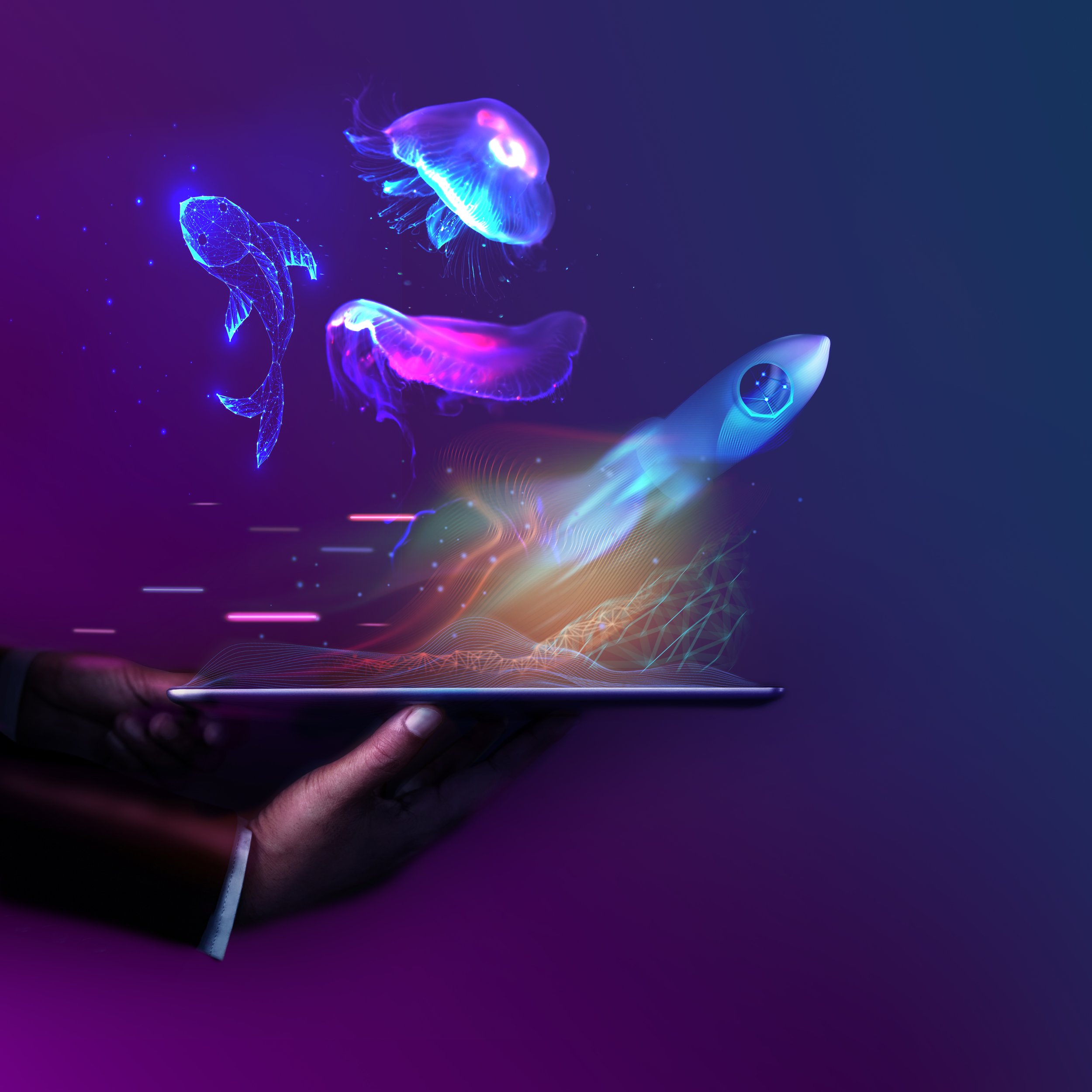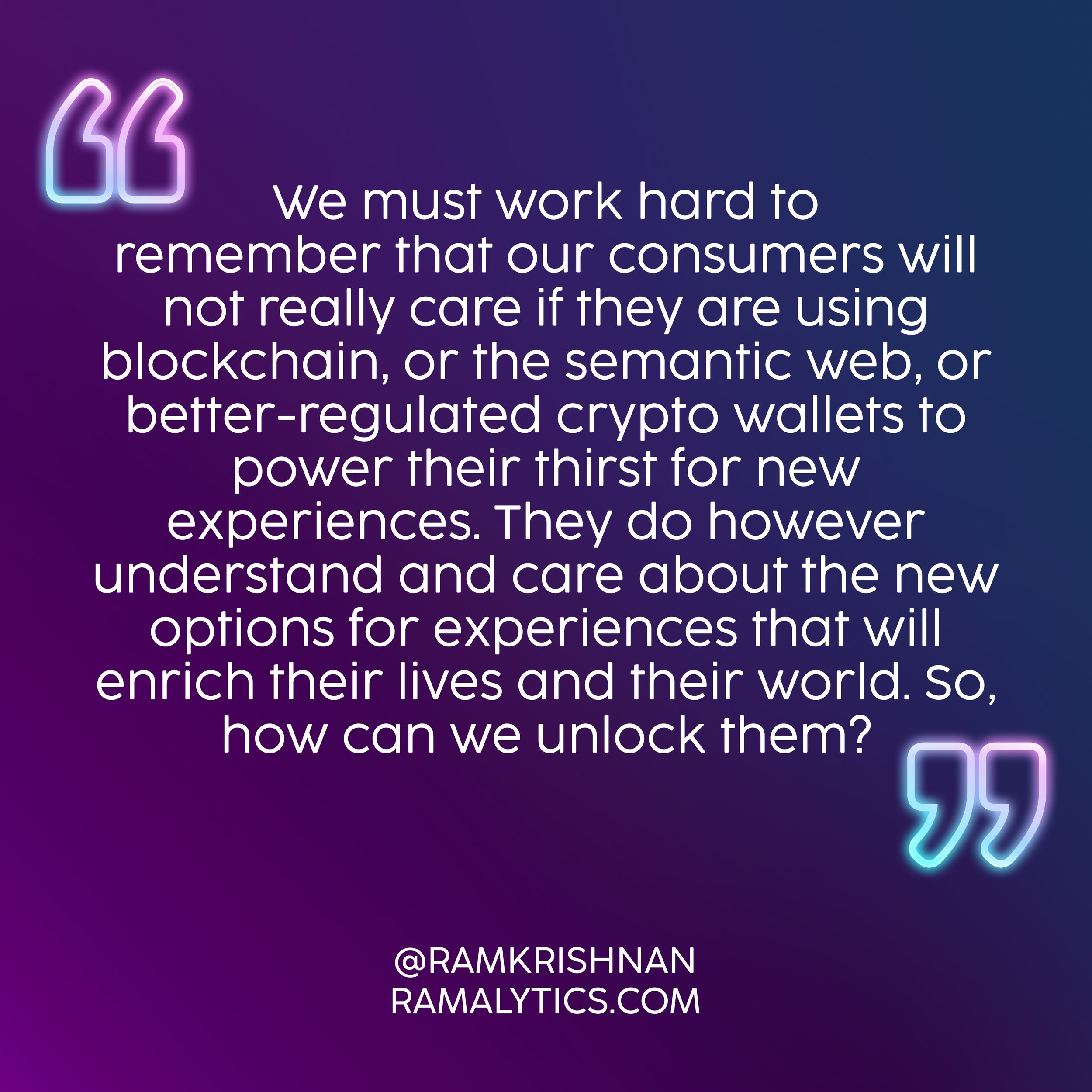Unlocking "Next Web" Experiences in 2023
The Next Web is here
In a previous blog, I spoke about the next generation of Internet as we know it – a more immersive and responsive internet that I’ve started calling the “Next Web.”
This “Next Web,” underpinned by Web3+ technologies, will decrease the barriers between the physical and digital, and will be able to respond, reason, and produce unique new content.
As I wrote in my last piece, I believe that we must work hard to remember that our consumers will not really care if they are using blockchain, or the semantic web, or better-regulated crypto wallets to power their thirst for new experiences. No more than they presently care that WiFi 7 is powering their livestreamed events or 5G is powering their smart home.
People will, however, understand and care about the new options for experiences that can enrich their lives and their world.
In 2023, I’ll be looking for the “Next Web” to unlock a number of new experiences with these themes:
UNLOCK EXPERIENCES
4 THEMES
#1: IMMERSIVE EXPERIENCES that transport people while further blurring the line between physical and digital.
Overall, internet spaces started to look a lot more like the physical world over the past year, due to availability of new technology that supports detailed-oriented design even without coding expertise. Roblox launched their Materials tool, which provides the ability to mimic even the most minute features of the physical world. Developers immediately leaned in to the ability to design hyper-real environments using a base of 35 materials like asphalt, cracked lava, granite, and leafy grass.
British fashion brand Charlotte Tilbury doubled down on efforts to create a hyper-real retail experience during Holiday ’22. The brand launched a new Personalized 3D Avatar that allows consumers to customize an avatar shopper using a range of features, including skin color, facial features, body type, clothing and makeup, then walk through the virtual store environment with friends. These uber-customized representations bring a new level of reality to the brand’s already-immersive storefront experience.
Experiments with virtual smell and taste. Current digital environments are largely limited to the audiovisual realm, but emerging applications explore how to embrace the full range of human senses. At this year’s CES, Vermont-based brand OVR showcased a headset that contains a cartridge with 8 primary smells that can be used to create different aromas, noting “Scent is now Digital.” Innovations like Haptx gloves experimented with how to bring touch to digital environments, for example simulating the feeling of rain on your face, or the sensation of shaking hands.
#2: BESPOKE EXPERIENCES, that go beyond cutting and pasting physical life into digital worlds to invent things that are wholly new.
One commonly searched term in 2022 was “Phygital,” a word referring to goods and experiences that are equal parts digital and physical…a “portmanteau” of the two. As AdAge notes, it may not be a new phrase, but it certainly gained new relevance via recent innovations that mash-up physical and digital touchpoints to create something new.
The Bored & Hungry NFT Restaurant: Canadian frozen-food manufacturer McCain Foods launched their new sustainably grown product called “Regen Fries” with a “Farms of the Future” game in the popular Roblox game Livetopia. The simulation allowed players to virtually “grow” potatoes using regenerative farming methods, then go and sample what they created at brick-and-mortar NFT pop-up restaurants across the country.
Ariana Grande’s summer concert in Fortnite allowed music lovers to reimagine the concert experience – as a multi-day, immersive experience complete with mini-games, concert skins, and sailing around the musician with millions of other co-fans. (Video recap on YouTube here)
The Friends With Benefits (FWB) Social Club creates a new version of the time-tested networking group. The Decentralized Autonomous Organization (DAO) functions as a social club and investor group. It has been compared to The Wing and SoHo House, both physical world clubs that offer networking benefits in exchange for membership fees. However, FWB requires crypto tokens to gain access to the group’s experiences, curated both via a Discord channel and in select cities. FWB currently has around 6,000 members and raised $10M from investors last year.
Finally, brands are experimenting with tokenized dining or travel to create bespoke experiences. The Flyfish Club is the first “Members Only” NFT restaurant, where membership is purchased as an NFT. Opening this year in Manhattan’s lower East Side, the 11,000sf space will feature an Omakase bar and access to myriad other fine dining experiences. While this is a premium experience, I can envision this type of bespoke creation expanding for mainstream consumers, too.
#3: BRAND PARTICIPATION EXPERIENCES, that leverage tech to deepen consumers’ relationships with their favorite brands by allowing them to not only engage, but to have a stake and participate.
Nike’s recent launch of Dot Swoosh, which promises product co-creation partnerships with everyday customers, among other participatory opportunities. The brand intends that their new platform and ecosystem that will house all of their Web3 activations and NFT drops. Registered community members will be able to buy/collect, show off and trade their Nike virtual merchandise, and eventually help co-create physical products by influencing design choices or even suggesting completely new ones.
In sports, the PGA (and other leagues too) partnered with NFT marketplace Autograph to create their own dedicated platform. It allows fans to collect and own NFT moments of golf history but also seeks to reimagine the way fans interact with players, by unlocking access to exclusive digital and onsite experiences with athletes and other golf professionals.
And of course, as I have written previously, Web3 technology is sparking experimental organizations with decentralized leadership and shared governance and profits. These so-called “Headless Brands” (or Decentralized Autonomous Organizations/ DAOs) are popping up across verticals and industries. I was surprised to learn while researching this piece that DAOs held over $16B AUM in December of last year – a 40 fold increase from the previous year. Organizations like Decentraland, MetaFactory, and Vita DAO are challenging the conventional model of a physically-anchored company led by a single person or leadership group. They provide a new way to think about the purpose of a company and how it should run.
#4: CREATIVE EXPERIENCES, that utilize Immersive AI tools to redefine the line between creator/consumer.
Tools like Chat GPT, DALL-E, Midjourney and Dream Fusion are among the most exciting pieces of current “Next Web” tech, because they put “synthetic creativity” into the hands of average people.
I find Midjourney very interesting, because it allows every consumer the ability to dabble in artistic expression, along with a participatory community. Midjourney runs on the Discord platform, which started as a place for gamers to hang out and chat, but has evolved into a broader audience. To create, you jump into a Discord community and use an “/Imagine” prompt to type in a visual creation you’d like to see. The discussion moves quickly, and in the process of seeing your own creative outputs, users see and experience the artistic explorations of other community members as well.
In another realm, it’s been interesting to follow the progress of cooking enthusiasts who are using AI-powered chatbots like ChatGPT to find or create new recipes. “ChatGPT recently gave me a vegan version of a bœuf bourguignon recipe, adjusting the proportions to make a single serving,” writes The Information’s Arielle Pardes, “Show me a recipe blog that can do that!”
I love the idea that immersive AI tools allow anyone to become a “creator,” regardless of whether they have traditionally considered themselves ‘creative’ or not.
How to Engage in a “Next Web” World
The “Next Web” -- and the new tools and experiences it brings – is a shift that could be likened to the leap from mainframe computers for enterprise to the PC.
As we read and learn more about these tools, we quickly understand it is not as simple as “clicking a button.” There are prompt whisperers, and companies who sell prompts to others, and artists who spend hundreds of hours and iterations to “coax” images from the AI.
For brands and retailers, the question is how do we lean into this new world to learn and engage, right alongside our customers?
Doing so will undoubtedly help uncover new products, new marketing ideas, and new revenue streams.
There is a lot to learn and discover (not to mention keeping an eye on the evolving legal and privacy landscape). But like so many others, I can’t help but be excited by the possibilities.
STAY CURIOUS
As a parting thought, something I see staying constant in the “Next Web” is the need to unlock curiosity.
One of the things that strikes me about the world of generative AI and the immersive Internet is the fact that you still need a very human foundation of ideas, inspiration, and creativity to build it.
GPT or DALL-E users must have a command of genres and artistic styles or the right prompt language to coax their desired text or images from the machine. Just as those inventing new designs or experiences in the Sandbox or Decentraland still need a broad-based command of physical world destinations, architectural styles, and consumer needs to create new things that will resonate.
This foundation is a pre-requisite for the “Next Web” experience builder. It still emerges from a growth mindset. It is cultivated through broad reading, travel, curious questions, and even unplugging to pursue a passion.
I encourage you to keep the cultivation of creativity on your 2023 priority list and to become an advocate for this practice within your sphere of influence.
Keep getting out there to explore the things that interest you. Keep pursing the paths to unlock new experiences in the “Next Web,” and together we will realize the next version of the internet, whatever it will be called.


